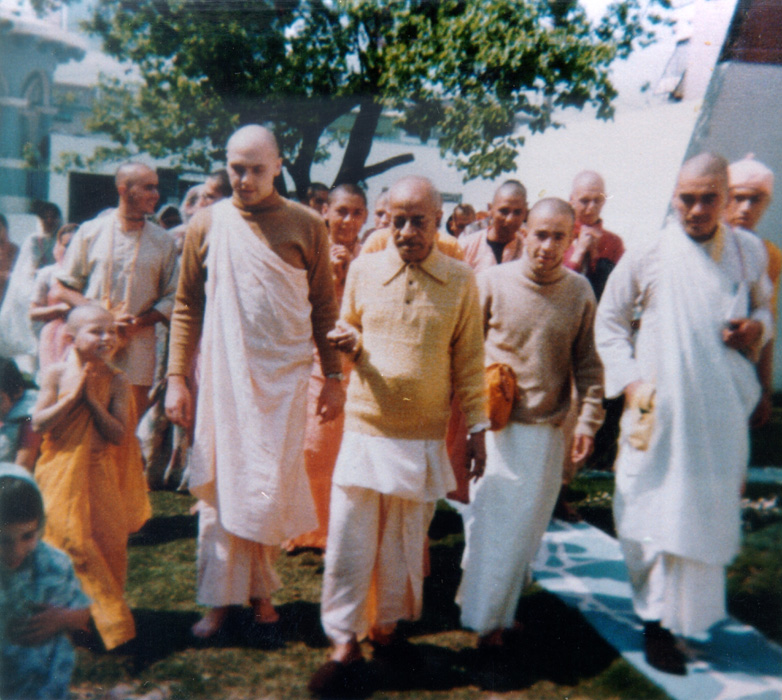Temple Profile: Mexico City
By Madhava Smullen | Июн 19, 2011

Name: Templo Hare Krishna
Address: Gobernador Tiburcio Montien, No. 45 Col., San Miguel, Chapultepec
Phone: (5) 5272-5944
Email: maitreya_dasa@krishnamexico.com
Website: www.krishnamexico.com
Presiding Deities: Sri-Sri Radha Madana-Gopala
President: Maitreya Dasa
Opened in: Fall 1971
Temple Style: Formerly the Ethopian Embassy in Mexico, the building incorporates both classical Spanish and Middle Eastern archietecture.
Расположение: Chapultepec, an affluent neighborhood and home to offices, a university, and some of the best known parks in the city. Los Pinos, the official residence and main workplace of Mexican president Felipe Calderón, lies a few blocks from the temple.
Distinctive food offerings: Mexican favorites such as Nopales, stuffed peppers, tamales, and quesadillas.
Number of residents: 22
Number of visitors: 150 per week, thirty per cent of whom tend to be newcomers.
Best time of year to visit: During any large festival, but especially May, when Rathayatra, the Festival of the Chariots, is celebrated. Of course, visitors are very welcome all year around.
ISKCON’s Mexico City temple is one of the society’s treasures, as the current building is the same one that ISKCON founder Srila Prabhupada sent his disciple Chitsukhananda to open in 1971. Prabhupada also visited it himself on two occasions, and the room in which he stayed has been kept as a shrine to this day.
“I arrived in Mexico City on June 1st, 1971,” recalls Chitsukhananda, who was the first devotee to go to Latin America, and whose desire to spread Krishna consciousness in Spanish was enthusiastically granted by Srila Prabhupada. “On my first day there, I met Mr. Francisco Balderama, who later became
Prakasananda Dasa. In the first week, I went on Jacobo Zabludovski’s show ‘24 Horas’ on national television. I was greatly assisted by by Alfonso Araiza, a lawyer who helped me translate various small books such as Easy Journey to Other Planets.”
Chitsukhananda rented a small house at first, then acquired the current temple in Fall of 1971. The first followers were an upscale group of doctors, lawyers, and engineers who had left the Swami they had been practicing yoga with because of his loose morals.
Almost immediately, Krishna conciousness in Mexico became a phenomenon, with the the temple rocking to the tune of 500 guests every Sunday. Local people joined, creating a blend of the high class intelligencia, college students, and hippies. Mothers and housewives also joined along with their children.
Soon, many devotees arrived from the U.S. too, making the Mexico City temple a vibrant and attractive cultural center with beautiful kirtans, sumptuous prasadam and festivals that went on late into the night.
Much of this success could be attributed to Srila Prabhupada’s visits to Mexico City in June 1972 and February 1975.

“In 1972 Prabhupada also appeared on Jacobo Zabludovski’s highly popular national television program, and his interview was seen by tens of millions,” Chitsukhananda says. “The ‘Hare Krishnas’ became widely known.”
Of course, Srila Prabhupada also visited the temple, saying that he was very happy to see the simplicity and artistic nature of the devotees. He also expressed his affinity for the temple building, and said that the devotees should keep it.
And so they did. To this very day.
Although the giddy heights of the 1970s have leveled out, the temple is still a hub of activity.
“Our central and convenient location lends to an always increasing number of visitors,” says ISKCON’s Governing Body Comissioner for Mexico, Guru Prasad Swami. “On an average day, we’ll have twenty to forty people attending our evening Bhagavad-gita class. We’ve also emphasized the importance of book distribution over the years, which is a major factor in bringing hundreds of newcomers to the temple.”
ISKCON Mexico has kept book distribution its priority through thick and thin, and the Mexican people, who are pious by nature, are excellent customers.
“We have participated in different major book fares around the country for many years, bringing awareness of our literary contribution,” Guru Prasad Swami says. “We are well known as the society that has made Bhagavad-gita available to the Mexican public.”
In recent years Ratha-Yatra, launched in 2002, has further heightened the awareness of Krishna consciousness in Mexico. At the two-day weekend festival and parade featuring three chariots for Jagannath, Baladeva, and Subhadra, many people get the opportunity to see ISKCON’s rich cultural contribution.
Meanwhile the temple offers an attractive selection of regular classes and workshops in its lounge, including philosophy, yoga, and Bharat-Natyam Dance, while its adjoining restaurant is packed full every day.
ISKCON Mexico City is also active in its local community, with several well-attended Bhakti-vriksha congregational groups around the city.
“We also regularly participate in religious tolerance seminars and workshops with other religious groups,” says Guru Prasad Swami. “And we are often invited by social workers and psychologists to speak on how to counsel families and friends about overcoming sadness related to death.”
In the future, devotees hope to open one or two satellite centers in Mexico City, with the aim of attracting people who may be reluctant to visit a formal temple.
They also plan to expand their traveling festival tour, which operates sporadically at present, to a more regular program, and to acquire land for an agricultural project.
Their immediate attention, however, is focused on renovating the devotees’ ashram accommodation, building a fully-equipped kitchen for festivals, and constructing private guestrooms—three urgent projects that have been delayed due to a lack of funds.
“Since Srila Prabhupada visited this temple twice, it is not only Mexico’s temple, but a place of pilgrimage that must be preserved for the whole society of ISKCON,” Guru Prasad Swami concludes.















